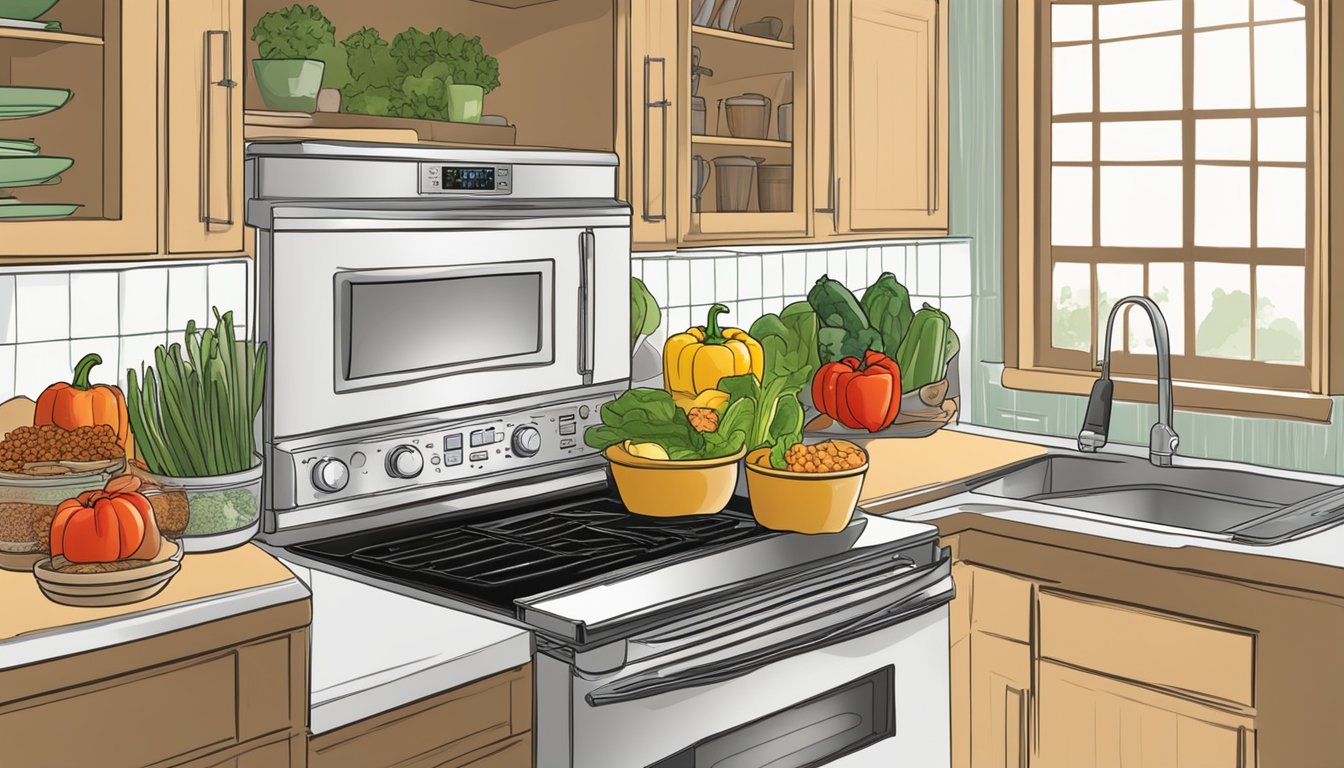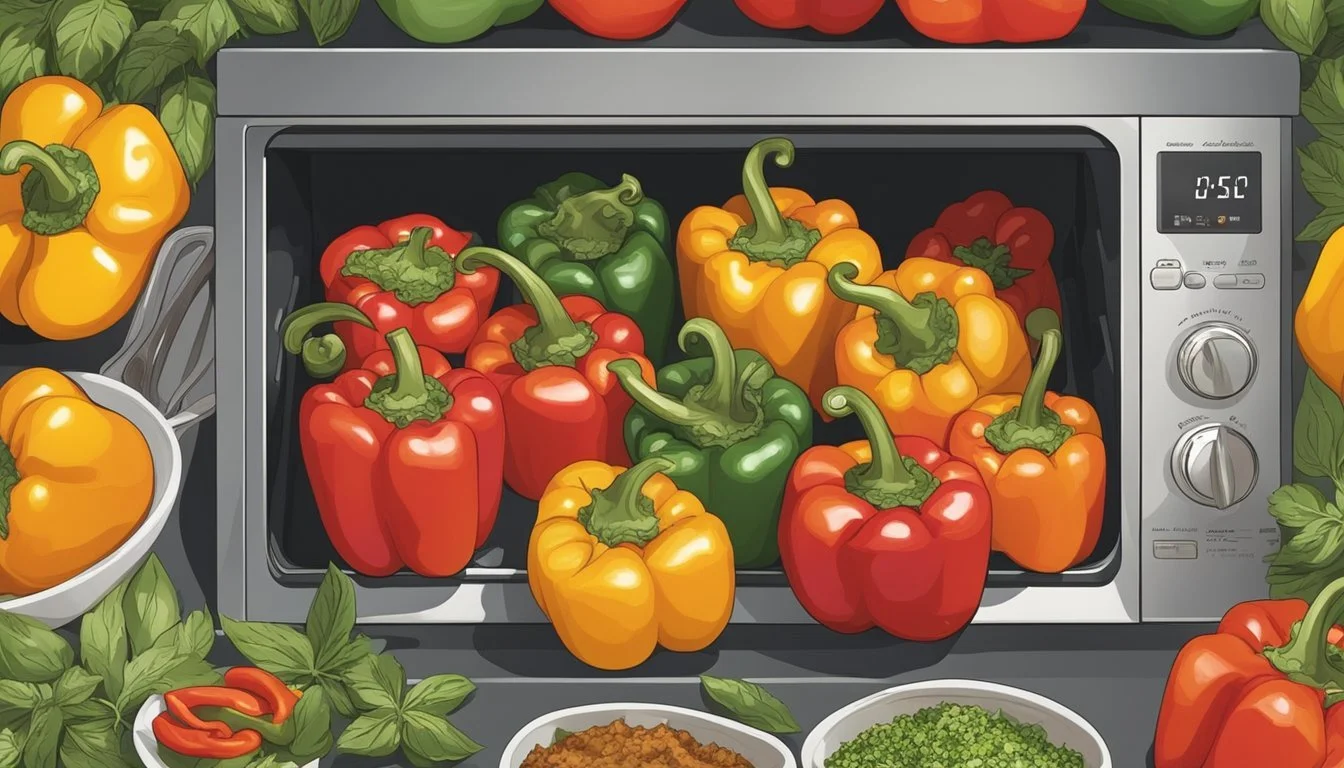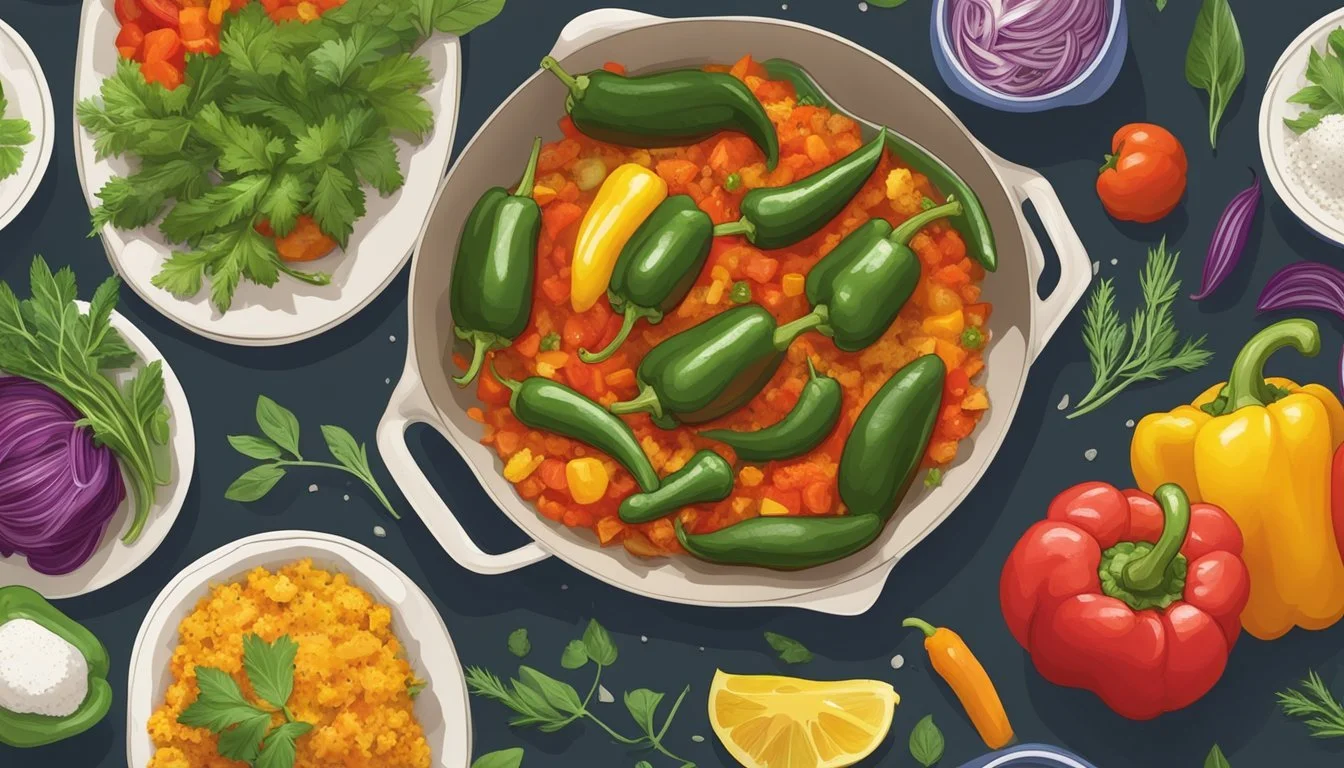How to Reheat Gluten-Free Stuffed Peppers
Best Methods and Tips
Gluten-free stuffed peppers make for a delicious and nutritious meal, but knowing how to reheat them properly ensures they retain their flavor and texture. To reheat gluten-free stuffed peppers, using an oven set to 350°F (180°C) is ideal. This method allows the peppers to be evenly heated through without risking the outer layer burning.
Alternatively, for those short on time, the microwave can be a quick option. Simply place the peppers in the microwave and heat them for 20-30 seconds, checking frequently to avoid overheating. Both methods help maintain the integrity of the gluten-free recipe, ensuring a satisfying meal whenever you choose to enjoy it again.
Reheating stuffed peppers correctly can make all the difference in preserving their delicious taste and texture. By following the right steps, whether using an oven or a microwave, one can enjoy gluten-free stuffed peppers just as much as when they were first prepared.
Choosing the Right Ingredients
Selecting the best ingredients is crucial to ensure that your gluten-free stuffed peppers are both delicious and safe for those with gluten sensitivities. Focus on fresh produce, high-quality proteins, and gluten-free fillers to achieve a delightful and nutritious meal.
Selecting Bell Peppers
Bell peppers come in various colors, including red, yellow, green, and orange. They should be firm to the touch and have smooth, shiny skin without any blemishes or soft spots.
Red peppers are sweeter compared to green ones, which have a slightly bitter taste. Choose peppers that stand upright on their own, as they are easier to stuff and cook evenly.
Opting for Gluten-Free Fillings
For those maintaining a gluten-free diet, it's important to choose appropriate fillings. Rice and quinoa are excellent options. They not only add bulk but also provide essential nutrients.
Ensure that any packaged ingredients like rice or quinoa are certified gluten-free. Avoid fillers that contain gluten, such as certain breadcrumbs or processed grains. Always double-check labels to avoid cross-contamination.
Choosing the Right Proteins
Ground beef, chicken, and turkey are popular choices for stuffed peppers. Each of these proteins offers a distinct flavor and texture. Choose lean cuts to maintain a healthier dish.
Cook the meat thoroughly before stuffing to ensure food safety. For a vegetarian option, consider legumes like black beans or lentils, which are also rich in protein and fiber.
Freshness of Herbs and Spices
Herbs and spices add essential flavor to your stuffed peppers. Fresh garlic, onions, and tomatoes provide a robust base. Choose fresh parsley, as it enhances the flavor profile and adds a touch of brightness.
Salt and pepper are basics, but you can also incorporate spices like cumin, paprika, and oregano for added depth. Use olive oil sparingly to sauté vegetables and meats, ensuring a harmonious blend of flavors.
Preparation Techniques
Before reheating stuffed peppers, ensure the ingredients and filling are properly prepared. Attention to detail in cooking rice or quinoa, mixing the filling, and stuffing the peppers is crucial for a delicious outcome.
Cooking Rice or Quinoa
Rice or quinoa serves as the base of the stuffing. Start by rinsing these grains under cold water to remove excess starch or debris. For rice, use a ratio of 2 cups water to 1 cup rice. Bring the water to a boil, add the rice, reduce the heat, and let it simmer for 18-20 minutes until tender.
For quinoa, use a ratio of 1 3/4 cups water to 1 cup quinoa. Bring to a boil, cover, and let it simmer for about 15 minutes or until the water is absorbed. Fluff the grains with a fork once cooked. Let them cool slightly before mixing with other ingredients.
Mixing the Filling
In a large mixing bowl, combine the cooked rice or quinoa with other ingredients like ground turkey, ground chicken, and chopped vegetables such as onions, bell peppers, and tomatoes. Season with salt, pepper, garlic powder, and other desired spices.
Mix the ingredients thoroughly until they are well-integrated. Ensure that the meat and vegetables are evenly distributed to achieve a balanced flavor in each bite. If using cheese, consider adding it at this stage to ensure it melts evenly throughout the filling.
Stuffing the Peppers
Prepare the bell peppers by slicing off the tops and removing the seeds and membranes. You can use a spoon or knife for this. Lightly season the inside of the peppers with salt and pepper for added flavor.
Fill the cavity of each pepper with the mixed filling, pressing down gently to pack it in without overstuffing. Place the stuffed peppers in a baking dish, arranging them upright to prevent spilling.
If you prefer, top the stuffed peppers with additional cheese or breadcrumbs for added texture. Bake in a preheated oven at 375°F (190°C) for 25-30 minutes, or until the peppers are tender and the filling is heated through.
Using these preparation techniques ensures that your gluten-free stuffed peppers will have an even, delicious flavor and texture when reheated.
Proper Baking Methods
Reheating gluten-free stuffed peppers in the oven ensures even heating and preserves their texture. This method is straightforward and highly effective.
Oven Baking the Stuffed Peppers
1. Preheat the oven: Set the oven to 350°F (180°C) for consistent warming.
2. Prepare the baking dish: Arrange the stuffed peppers in an oven-proof dish. For added moisture, sprinkle a tablespoon of water over them.
3. Cover the dish: Use foil or a lid to cover the baking dish. This helps retain heat and prevents the peppers from drying out.
4. Bake: Place the covered dish in the preheated oven. Bake for 15-20 minutes.
5. Check temperature: If desired, use a food thermometer to ensure the internal temperature reaches 165°F (74°C).
Proper baking guarantees gluten-free stuffed peppers are perfectly reheated without losing flavor.
Storing and Preserving
Proper storage methods are crucial to keep your gluten-free stuffed peppers fresh and tasty. This section covers using airtight containers and freezing for long-term storage.
Using Airtight Containers
Storing leftovers in airtight containers is essential to maintain their freshness and prevent contamination. It is recommended to cool the stuffed peppers completely before storing them.
Place the cooled peppers in a glass or BPA-free plastic container with a tight-fitting lid. This helps to lock in moisture and flavor while keeping out unwanted odors.
Store the containers in the refrigerator, where they can last up to 3-4 days. To reheat, use a microwave or oven, ensuring the internal temperature reaches at least 165°F (74°C).
Freezing for Long-Term Storage
If you need to store the gluten-free stuffed peppers for a longer period, freezing is an excellent option. To begin, let the peppers cool completely to avoid condensation, which can create ice crystals and affect texture.
Wrap each pepper individually in plastic wrap or aluminum foil to prevent freezer burn. Place the wrapped peppers in a freezer-safe airtight container or zip-lock freezer bag.
Label the container with the date before placing it in the freezer. Gluten-free stuffed peppers can be frozen for up to 3 months. To reheat, thaw the peppers overnight in the refrigerator and then follow your preferred reheating method, ensuring they reach a safe internal temperature.
Reheating Instructions
Proper reheating ensures gluten-free stuffed peppers remain delicious while retaining their texture. The following methods detail how to reheat using an oven or a microwave.
Oven Reheating Method
Preheat the oven to 350°F (180°C). Place the stuffed peppers in an oven-proof dish. To avoid drying out, sprinkle a tablespoon of water over them and cover with aluminum foil. This keeps the moisture in, ensuring the peppers are heated evenly.
Bake the peppers for approximately 20 minutes. If coming from a frozen state, it may take closer to 40 minutes. Check after 15 minutes, ensuring even heating. The internal temperature should reach at least 165°F (74°C) for safe consumption. Once done, let them rest for a few minutes. This allows the heat to distribute evenly.
Microwave Reheating Tips
Place the stuffed peppers in a microwave-safe dish. Heat on medium power for 2-3 minutes. Pause halfway to check the temperature and stir the filling if possible. This ensures even heating throughout the pepper.
Continue reheating in 30-second intervals until the desired temperature is reached. For large peppers, consider giving them a 20-30 second blast in the microwave before transferring them to the oven. This hybrid approach speeds up the process while maintaining quality.
Allow the peppers to rest for a minute or two before serving. This step is crucial to let the heat spread evenly and provide a more enjoyable eating experience.
Customizing Your Stuffed Peppers
Customizing gluten-free stuffed peppers allows you to cater to various dietary preferences and restrictions, as well as to experiment with different tastes and textures. Here are some tips on substitutions and varying proteins to make your stuffed peppers both delicious and versatile.
Substitutions for Dietary Restrictions
For those needing dairy-free options, consider using vegan cheese or nutritional yeast in place of traditional cheeses. Coconut or almond milk can replace cream-based ingredients for a rich, creamy texture.
Gluten-free breadcrumbs or cooked quinoa work well as substitutes for regular breadcrumbs. Ensure that all seasonings are certified gluten-free to avoid contamination.
For a paleo lifestyle, swap out any legumes or rice with vegetables like cauliflower rice or riced sweet potatoes. Keto-friendly and whole-food options, like nuts or seeds, can add a satisfying crunch.
Vegan varieties can be made by using plant-based proteins such as tofu, tempeh, or beans (ensure they fit gluten-free needs). Mixed vegetables and grains like lentils or wild rice offer hearty choices too.
Varying Your Proteins
The traditional filling often comprises ground beef, but there are numerous alternatives to explore. Ground turkey or chicken are leaner options that deliver a different taste and texture.
For a richer flavor, ground lamb or pork can be utilized, providing a different spectrum of tastes. They pair especially well with festive spices.
In plant-based preparations, lentils and chickpeas offer substantial protein content. Tofu or tempeh can be seasoned to mimic the flavors of traditional meat fillings. Adding mushrooms or quinoa enhances texture and nutrition.
Experimenting with these substitutions and protein variations can help you tailor stuffed peppers to diverse tastes and nutritional goals.
Health Benefits
Gluten-free stuffed peppers not only fit dietary restrictions but also provide various essential nutrients and antioxidants beneficial for overall health. This section outlines their major nutritional content and health advantages.
Nutritional Content Overview
Nutrients: Gluten-free stuffed peppers typically contain lean proteins such as ground turkey or beef, which are vital for muscle repair and growth. Whole grains like brown rice or quinoa often serve as a fiber-rich base, promoting digestive health.
Vitamins: These stuffed peppers are packed with vitamins A, C, and K. Vitamin A supports eye health, Vitamin C boosts the immune system, and Vitamin K aids in blood clotting. Additionally, the dish contains B-vitamins from meat and grains, essential for energy metabolism.
Antioxidants: Bell peppers, a key ingredient, are rich in antioxidants like beta-carotene and flavonoids, which help fight oxidative stress and reduce inflammation.
Healthy Fats: Incorporating ingredients like olive oil provides healthy fats, contributing to heart health.
Overall, gluten-free stuffed peppers make for a nutritious, balanced meal.







